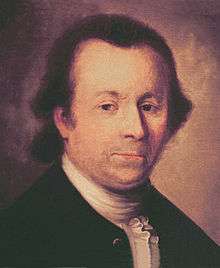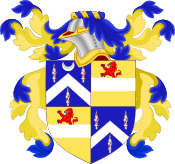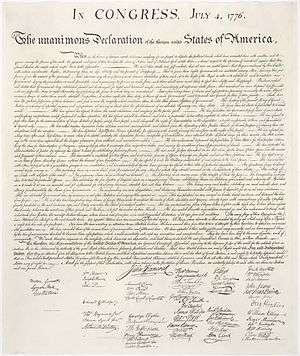Button Gwinnett
Button Gwinnett (1735 – May 19, 1777) was a British-born American founding father who, as a representative of Georgia to the Continental Congress, was one of the signatories (first signature on the left) on the United States Declaration of Independence. He was also, briefly, the provisional president of Georgia in 1777, and Gwinnett County (now a major suburb of metropolitan Atlanta) was named for him. Gwinnett was killed in a duel by rival Lachlan McIntosh following a dispute after a failed invasion of East Florida.
Button Gwinnett | |
|---|---|
 Portrait by Nathaniel Hone | |
| Governor of Georgia | |
| In office February 22, 1777 – May 8, 1777 | |
| Preceded by | Archibald Bulloch |
| Succeeded by | John Adam Treutlen |
| Delegate from Georgia to the Continental Congress | |
| In office 1777–1777 | |
| Personal details | |
| Born | 1735 Down Hatherley, Gloucestershire, Great Britain |
| Died | (aged 42) Near Savannah, Georgia, U.S. |
| Nationality | British/American |
| Spouse(s) | Ann Bourne |
| Occupation | Merchant, planter, congressman |
| Profession | Governor of Georgia |
| Signature | |
Early life and education

Gwinnett was born in 1735 in the parish of Down Hatherley in the county of Gloucestershire, Great Britain, to a Welsh father, the Reverend Samuel Gwinnett, (Gwinnett deriving from the Welsh county of Gwynedd) and his wife, Anne. He was the third of his parents' seven children, born after his older sister Anna Maria and his older brother Samuel. There are conflicting reports as to his exact birthdate, but he was baptized in St Catherine's Church in Gloucester on April 10, 1735. It is believed that he attended the College School, held in Gloucester Cathedral (now called The King's School) as did his older brother, but there is no surviving evidence to substantiate this. He started his career as a merchant in England. He moved to Wolverhampton in 1754, and in 1757 at age twenty-two, he married a local, Ann Bourne, at St. Peter's Church. In 1762 the couple departed Wolverhampton and emigrated to America.
Gwinnett's business activities took him from Newfoundland to Jamaica. Never very successful, he moved to Savannah in 1765 and opened a store. When that venture failed, he bought (on credit) St. Catherine's Island,[1] off the coast of Georgia, to the south of Savannah, and attempted to become a planter. Though his planting activities were also unsuccessful, he did make a name for himself in local politics.[2]
Career
Arriving first in Charleston, Province of South Carolina, by 1765 Gwinnett and his wife had moved to the Province of Georgia. Gwinnett abandoned his mercantile pursuits, selling off all his merchandise to buy a tract of land where he started a plantation. Though unsuccessful as a planter, by 1769 he had gained such local prominence that he was elected to the Provincial Assembly.
Gwinnett did not become a strong advocate of colonial rights until 1775, when St. John's Parish, which encompassed his lands, threatened to secede from Georgia due to the colony's rather conservative response to the events of the times. During his tenure in the Assembly, Gwinnett's chief rival was Lachlan McIntosh, and Lyman Hall was his closest ally. Gwinnett's rivalry with McIntosh began when McIntosh was appointed as brigadier general of the Georgia Continentals in 1776.[3]
American Revolutionary War
Gwinnett voted in favor of the Declaration of Independence, adopted by Congress on July 2, 1776, two days before the "fair copy," dated July 4, 1776, was presented to the Congress. He signed the famous parchment copy on August 2, 1776. After signing the Declaration, he was accompanied as far as Virginia by Carter Braxton, another of the signers, carrying a proposed state constitution drawn up by John Adams. During his service in the Continental Congress, Gwinnett was a candidate for a brigadier general position to lead the 1st Regiment in the Continental Army, but lost out to Lachlan McIntosh. The loss of the position to his rival embittered Gwinnett greatly.
Gwinnett served in the Georgia state legislature, and in 1777 he wrote the original draft of Georgia's first State Constitution. He soon became Speaker of the Georgia Assembly, a position he held until the death of the President (Governor) of Georgia, Archibald Bulloch. Gwinnett was elevated to the vacated position by the Assembly's Executive Council.[4] In this position, he sought to undermine the leadership of McIntosh.
Tensions between Gwinnett and McIntosh reached a boiling point when the General Assembly voted to approve Gwinnett's attack on British Florida in April 1777.[5]
Death
In early 1777, Gwinnett and his allies gained control of the Georgia Provisional Congress, and he became acting President of the Congress and commander-in-chief of Georgia's military. As such, he was now the superior of his rival Lachlan McIntosh. Gwinnett had McIntosh's brother arrested and charged with treason. He also ordered McIntosh to lead an invasion of British-controlled East Florida, which failed. Gwinnett and McIntosh blamed each other for the defeat, and McIntosh publicly called Gwinnett "a scoundrel and lying rascal".[6]
Gwinnett then challenged McIntosh to a duel, which they fought on May 16, 1777, at a plantation owned by deposed Royal Governor James Wright.[7] The two men exchanged pistol shots at twelve paces, and both were wounded.[8] Gwinnett died of his wounds on May 19, 1777, and he was later buried in Savannah's Colonial Park Cemetery.[9] McIntosh, although wounded, quickly recovered and went on to live until 1806. He was never charged in connection with Gwinnett's death.
Gwinnett was succeeded in his leadership position by fellow revolutionary John Treutlen, who became the first person to hold the official title of "governor" of Georgia under American administration. (By coincidence, Treutlen himself was slain a few years later, reportedly by a mob.)
Legacy
Gwinnett's autograph is highly sought by collectors as a result of a combination of the desire by many top collectors to acquire a complete set of autographs by all 56 signers of the U.S. Declaration of Independence, and the extreme rarity of the Gwinnett signature; there are 51 known examples,[10] since Gwinnett was fairly obscure prior to signing the Declaration and died shortly afterward. Only ten of those are in private hands.[11]
Spencer Tracy in the 1958 film The Last Hurrah says, "Oh, I'm afraid my signature will never become as rare as Button Gwinnett."
In the 1932 film Washington Merry Go Round, Lee Tracy plays a character named after Gwinnett.
In the episode "Who let you in?" of Mr. Show with Bob and David, Gwinnett is one of the five Founding Fathers portrayed in an absurdist sketch (together with Thomas Jefferson, Benjamin Franklin, and Abraham Lincoln) describing the invention of the American flag. He is frequently bullied by the other Founding Fathers.
The rarity of Button Gwinnett's signature was a plot point in Season 6, Episode 3 the CBS show Elementary. The episode, aired on May 14, 2018, focused on the rarity of Gwinnett's signature as a motive for murder. However, lead character Sherlock Holmes got it wrong when he said Gwinnett "died shortly after the war." Gwinnett actually died during the war.
Gwinnett County, Georgia, now a suburban area of Atlanta, is named after him.[12]
Georgia Gwinnett College has celebrated Button Gwinnett Day since 2011.
In December 2015, Stephen Colbert and Lin-Manuel Miranda performed a rap song about Gwinnett in the style of the musical Hamilton on The Late Show with Stephen Colbert.[13]
Button Gwinnett is featured in Fallout 3 as a protection robot guarding the National Archives Building, wearing a wig and speaking in a colonial American accent. In Fallout 4, a brewery is his namesake as a nod to the Samuel Adams Brewery and is located in Boston, using a logo that sports a portrait of him saying "Southie Stout" followed by his name Button Gwinnett.
A rare Button Gwinnett signature is referenced in an episode of the private detective series Mannix titled “A Button for General D.” [14]
See also
- Founding Fathers of the United States
- List of residents of Wolverhampton
- Washington Merry-Go-Round, a 1932 film starring Lee Tracy as Button Gwinnett Brown, a fictitious modern-day Congressman and descendant of Button Gwinnett
- "Button! Button!", an Isaac Asimov story featuring a time travel viewing and matter synthesis device in which a collector may create a scrap of parchment with Gwinnett's signature, duplicated from the Declaration of Independence.
- List of U.S. state governors born outside the United States
References
- "Gwinnett House (Saint Catherines Island, Ga.)". John Linley, Box 19. Georgia Archives. Retrieved 24 May 2016.
- Jackson, Harvey H. (2010). American National Biography. London: Oxford University Press. Retrieved 24 May 2016.
- Russell, David Lee (2006). Oglethorpe and colonial Georgia : a history, 1733-1783. Jefferson, N.C.: McFarland. p. 84. ISBN 0786422335. Retrieved 24 May 2016.
- "Gwinnett, Button, Appointment as President and Commander-in-Chief of the State of Georgia, Mar. 4, 1777". Commissions, State Officers Appointments, Assembly, Colony of Georgia, RG 49-1-10. Georgia Archives. Retrieved 23 May 2016.
- Jackson, Harvey H. (1979). Lachlan McIntosh and the politics of Revolutionary Georgia. Athens: University of Georgia Press. p. 64. ISBN 082030459X. Retrieved 24 May 2016.
- "To George Washington from George Walton, 5 August 1777". Founders Online. National Archives. Retrieved 24 May 2016.
- Brooking, Greg (2014). ""Of Material Importance": Governor James Wright and the Siege of Savannah". Georgia Historical Quarterly. 98 (4). Retrieved 24 May 2016.
- Fleming, Thomas H. (2011). "When politics was not only nasty… but dangerous". American Heritage. 61 (1). Retrieved 24 May 2016.
- Lanman, Charles (1887). Biographical Annals of the Civil Government of the United States. New York: J. M. Morrison. p. 177.
- "Gwinnett, Button, Signature". Memorials and Quit Rents, Assembly, Colony of Georgia, RG 49-1-17. Georgia Archives. Retrieved 24 May 2016.
- "Buttons Not Buttons". Radiolab. WNYC. Retrieved December 12, 2014.
- Gannett, Henry (1905). The Origin of Certain Place Names in the United States. Govt. Print. Off. p. 146.
- "Lin-Manuel Miranda And Stephen Perform "Button!"". Retrieved September 15, 2016.
- https://www.imdb.com/title/tt0641522/
External links
- United States Congress. "Button Gwinnett (id: G000542)". Biographical Directory of the United States Congress.
- Biography of Button Gwinnett
- Georgia Signers of the Declaration of Independence
- New Georgia Encyclopedia
- Biography by Rev. Charles A. Goodrich, 1856
- Button Gwinnett at Find a Grave
- Button Gwinnett historical marker
| Political offices | ||
|---|---|---|
| Preceded by Archibald Bulloch |
Governor of Georgia 1777 |
Succeeded by John A. Treutlen |

